WebSci 2018
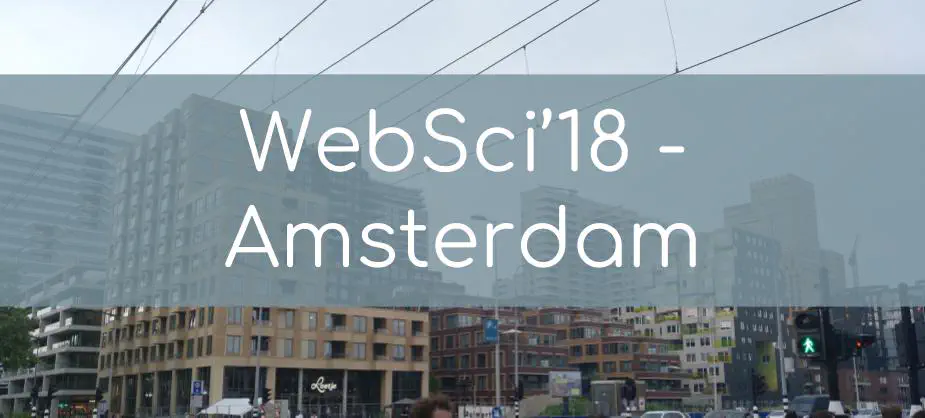
At the end of May I had the chance to attend the WebScience conference. A venue where computer scientists and social scientists meet! ACM Turing Lecture by Sir Tim Berners-Lee, adaptive learning analytics, roots of radicalisation on Twitter, internet regulation in Russia. These are only some of the very interesting topics. Continue reading for the full travel report.
Rather than chronologically list all the talks, I will focus on one or two talks per day which I liked the most and the social activities. Let’s first start with a bit of context, what is the WebSci conference?
The WebScience conference is all about the Web, the largest socio-technical network in human history, and aims to bring together researchers from various disciplines like computer science, sociology, economics or psychology. This year’s WebSci was already the 10th edition and one special agenda point was the ACM Turing Lecture held by Sir Tim Berners-Lee the inventor of the Web (beside the 150 conference attendees, 1,500 guests were expected).
What I liked the most The interdisciplinary approach of the conference. Algorithms and data meet sociological and psychological use-cases.
What I didn’t like Each session had a scheduled Q&A panel, but none of the sessions I attended made use of it and additionally some talks were out of sync across sessions which made it difficulty to switch talks within a session.
LILE workshop
I already attended the program on Sunday, as I had to present our work about Linked Data Generation for Adaptive Learning Analytics Systems in the Linked Learning workshop (LILE). Past editions were held together with semantic web conferences (ESWC or ISWC) and the WWW conference. This year focused more on interdisciplinary approaches (hence together with WebSci), which was also reflected in the scoring for the best paper award which was won by Simone Kopeinik and colleagues and their work about the adaption of an open source social bookmarking system to observe critical information behaviour. Congratulations!
A keynote was given by Inge Molenaar about Self regulated Learning, who early in the beginning of the talk also raised the question: “Which processes we want computers to take over?”. Later in the presentation I learned that self report is not a really good method to measure self regulation.
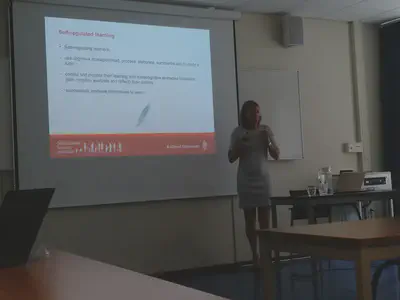
There was also a Keynote by John Domingue about Using Blockchains to Open Higher Education. I learned among other things about Uber style universities, which are basically virtual universities where a Blockchain is used to record and verify students ‘attendance’ in online courses, grades and diplomas.
Monday
The first official conference day started directly with the “Best of Web Science” session, where Miriam Fernandez talked about understanding the roots of radicalisation on Twitter. Their approach: “Don’t try to detect whether someone is radical, but measure the influence on the micro, meso and macro level”. Interesting fact is, that the terror organization ISIS has a weekly magazine which is now used by researchers to learn word embeddings for further research.
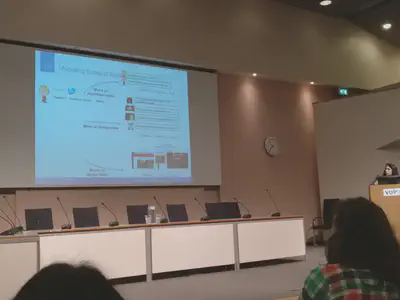
Another talk from that session focused on third party tracking in the mobile ecosystem. Reuben Binns pointed out that parent companies relationships often are data sharing relationships and that one app usual has 5 trackers installed. Their x-ray transparency tool is available at GitHub proudly presented to you by Mircosoft 😛 (which by the way was also mentioned in the talk as one most prevalent tracker company).
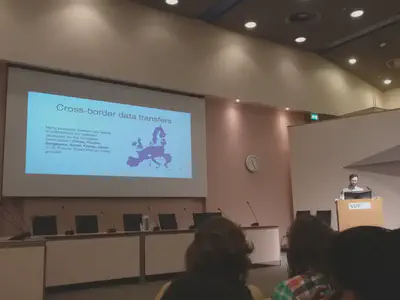
Later that day I mostly attended talks in the “Flow, Information and News” session. Interesting there, was the investigation of effects of Google’s result pages for evaluating the credibility of online news sources given by Emma Lurie. I learned that snopes.com performs fact-checking and that some study participants value social media signals like facebook ranking or tweet recency. More information can be found here.
Monday was also the poster session day. On the Web Science spectrum everything from the online media discourse in authoritarian elections in the case of 2016 St. Petersburg electoral campaign to Linkflows: enabling a web of linked semantic publishing workflows, everything was covered. The best poster award was given to Pip Thornton and her poster about {poem}.py. Famous poems or texts printed on a receipt next to their current monetary value determined by GoogleAdWords.
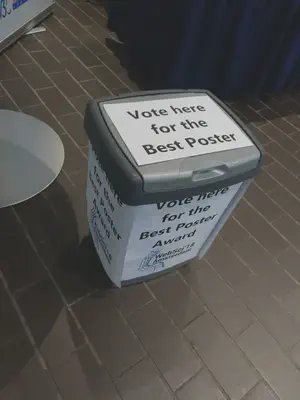
The day was rounded out with a social gathering and dinner for PhD students sponsored by Web Science Trust. It was tasty and fun, thank you!
Tuesday
Tuesday was in the shadow of the ACM Turing Lecture held by Sir Tim Berners-Lee (the inventor of the web). Next to the 150 conference participants around 1,500 more guests were expected. The difference between the Internet and the Web, according to Tim: When retrieving an server error while requesting a website, one can clearly see that the Internet works, but the web part has issues. An important take-home message for me was the call to make use of our rights and protest against initiatives which are threaten the Web, like cancellation of the net neutrality.
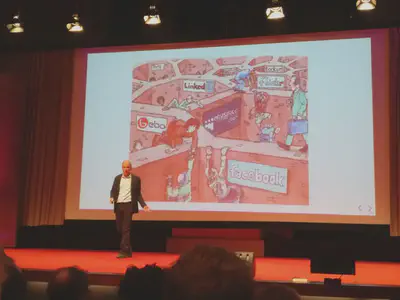
In the session “Methods and Practice” Alexander Darer was talking about the automatic discovery of internet censorship by web crawling. His colleagues and him tried to make transparent how countries block the Internet. One recommendation from the audience regarding the performed research was to take the initial seed list of blocked websites which was taken from Wikipedia and try to find similar sites using techniques like cluster analysis. Also a deeper analysis of the distribution of types of blocked websites was suggested (e.g. gambling, news, entertainment). This social science viewpoint on the data, which can improve the performed research, is in my opinion one of the main benefits of events like the WebSci!
Tuesday was also the day of the official social event of the conference. We had a nice boat tour (unfortunately with a bit of rain) through the canals of Amsterdam and ended up having dinner in the restaurant Ij-kantine, where also the awarding of best papers happened.
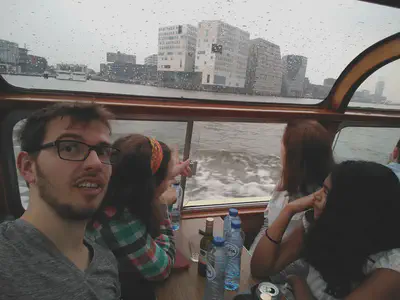
Wednesday
The last keynote of the conference was held by John Domingue and was about the future of semantics on the web. After going through some history of semantics, he talked about real-world issues regarding provenance and centralization. The windrush generation in the UK are British citizens who came to the UK from the Commonwealth. Their rights were guaranteed in the Immigration Act of 1971. But now according to a new law, these people have to prove continuous residence in the UK since 1973. A task which is hard to achieve if you don’t have detailed provenance of what you did in those years. The Home Office also destroyed the landing cards (which were centralized stored), which makes it even harder. The keynote was also about machine learning algorithms and how they can use RDF triples in a vector space model.
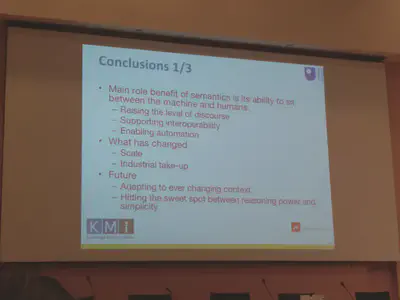
Beside the mentioned facts, my take home message from the talk was the position of semantics to sit in between machines and humans. Also that even though - as pointed out by Miriam Fernandez - semantics are subjective, the bias is at least visible and provenance can be expressed to see where the bias comes from.
Another interesting talk that day was Internet Regulation Media Coverage in Russia: Topics and Countries given by Anna Shirokanova, where I learned that a small blogger sphere went to a huge politics sphere in Russia. In the beginning of the 2000s a lot of Blogs existed which were also critically talking about the Government and that later on multiple laws were introduced to e.g. make bloggers recognize themselves as media companies (with regulations and obligations involved) or laws regarding the storage of data of Russian citizens and an anti VPN law.
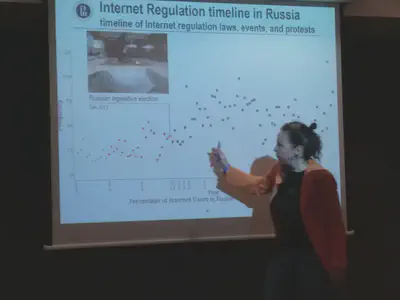
Gefion Thuermer was talking about online participation within the Green Party of Germany. According to a survey they made, young people think that online participation is a good thing for elderly, as they are not that mobile anymore. Similarly elderly think that online participation is a good thing for younger people as their are digital natives anyway. Future research will be a panel survey before and after the online participation tool gets introduced.
That was the WebScience conference from my perspective. As already pointed out, a great venue where Computer Science and Social Sciences meet. I met a lot of interesting people and hope to attend next year as well!
